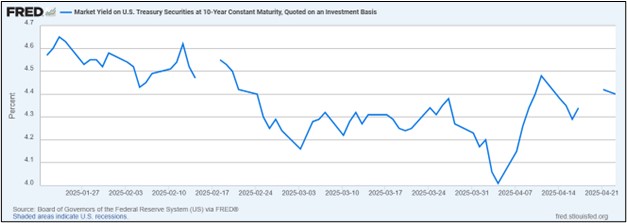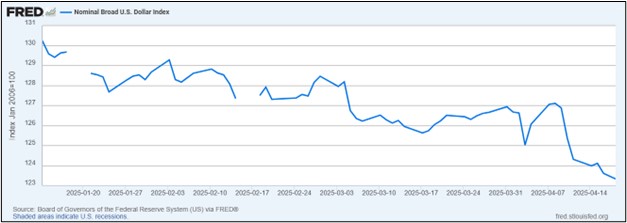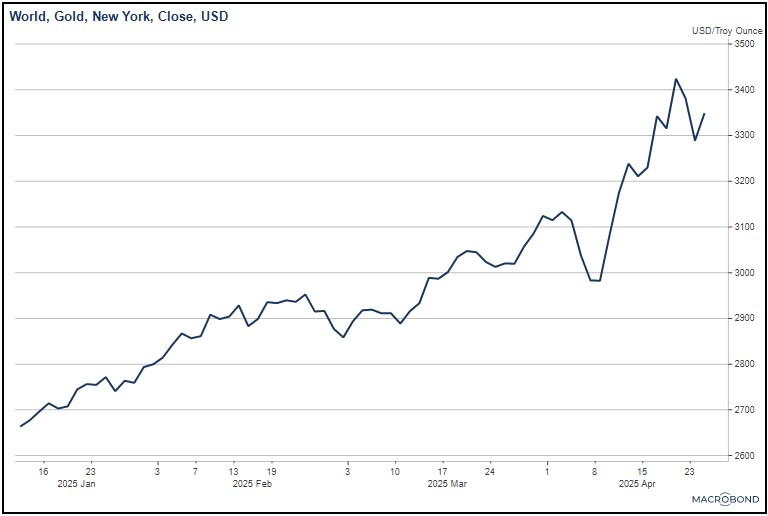Tag: capital flight
Asset Allocation Bi-Weekly – US Capital Flight and the Implications for Investors (May 5, 2025)
by Patrick Fearon-Hernandez, CFA | PDF
Oh, what a difference one calendar quarter can make! Shortly after Donald Trump was sworn in to his second term as president of the United States, we wrote that the US seemed to enjoy exceptional advantages versus the rest of the world in terms of its economic growth, political stability, and stock market returns. Other economists and market commentators echoed those views. However, just three months into Trump’s new term, many investors seem to be losing confidence in the US’s economic growth and management. As we discuss in this report, the evidence pointing in that direction includes a rise in the yields on US Treasury obligations, a depreciating dollar, and surging gold prices. Below, we discuss these trends and what they may mean for world financial markets going forward.
Reduced Bond Buying / Rising Bond Yields. As shown in the chart on the next page, the yield on the benchmark 10-year Treasury note stood at 4.57% on the first business day after Trump’s inauguration in January. Investors continued to scoop up Treasurys in the weeks following the ceremony, driven by expectations of slower economic growth, easing inflation pressures, and further interest rate cuts by the Federal Reserve. As the administration revealed more about its tariff plans and other aspects of economic policy, growing concerns about the US economy pushed 10-year Treasury yields as low as 4.01% in early April. Since then, however, Treasurys have sold off sharply. Importantly, it appears that foreign institutions in Japan and elsewhere have been a big part of the sell-off. In any case, 10-year Treasury yields have spiked to more than 4.40% since mid-April. The yield on 30-year Treasurys has spiked to as high as 4.91%.
A Depreciating Dollar. Just as US Treasurys have sold off, the dollar has depreciated against many key currencies. The chart below shows the Fed’s nominal US Dollar Index, which tracks the value of the greenback against a broad range of foreign currencies. The broad index shows the dollar has lost about 4.10% of its value since Inauguration Day, with an especially sharp drop since Trump announced the pause in his “reciprocal” tariffs on April 9. The dollar has especially fallen sharply against developed country currencies, such as the euro.
Rising Gold Prices. Rising bond yields and a falling dollar point to falling confidence in the US among global investors, so it should be no surprise that gold — the quintessential safe haven — has appreciated sharply. As shown in the next chart, gold prices have even reached a record high above $3,400 per ounce, with much of the increase coming since early April.
Of course, many long-term investors have been more focused on the recent volatility in US risk assets, especially stocks. In our view, the unique combination of market forces described above may be the more important underlying story. The rise in US bond yields, the decline in the dollar, and the surge in gold represent a rare alignment of market trends that may indicate some measure of capital flight from the US. This pattern of market moves suggests that global and even some domestic investors are trying to cut their exposure to US assets and the dollar. The likely culprit is the administration’s effort to rapidly and fundamentally change the US economic relationship with the rest of the world. As long as that endeavor continues, and investors are unsure of where the to-and-fro of policymaking will take them, these trends are likely to remain in place. Therefore, over the coming months and quarters, the most attractive assets may be much different than what we and other observers had expected at the start of the year. In particular, any continued US capital flight is likely to favor foreign equities, foreign currencies, and gold in the near term.
Don’t miss our accompanying podcasts, available on our website and most podcast platforms: Apple | Spotify
Weekly Geopolitical Report – The 2018 Geopolitical Outlook (December 18, 2017)
by Bill O’Grady
(N.B. This will be the last WGR of 2017. Our next report will be published January 8, 2018.)
As is our custom, we close out the current year with our outlook for the next one. This report is less a series of predictions as it is a list of potential geopolitical issues that we believe will dominate the international landscape in the upcoming year. It is not designed to be exhaustive; instead, it focuses on the “big picture” conditions that we believe will affect policy and markets going forward. They are listed in order of importance.
Issue #1: The Big Picture
Issue #2: China Deleveraging
Issue #3: European Politics
Issue #4: North Korea
Issue #5: South American Populism
Issue #6: The Middle East
Issue #7: U.S. Domestic Politics
Weekly Geopolitical Report – The Mid-Year Geopolitical Outlook (July 10, 2017)
by Bill O’Grady
As is our custom, we update our geopolitical outlook for the remainder of the year as the first half comes to a close. This report is less a series of predictions as it is a list of potential geopolitical issues that we believe will dominate the international landscape for the rest of the year. It is not designed to be exhaustive; instead, it focuses on the “big picture” conditions that we believe will affect policy and markets going forward. They are listed in order of importance.
Issue #1: The Political Fragmentation of the West
Issue #2: North Korea
Issue #3: An Unsettled Middle East
Issue #4: A Resurgent Russia
Issue #5: China’s Financial Situation
Weekly Geopolitical Report – The 2017 Geopolitical Outlook (December 12, 2016)
by Bill O’Grady
(This will be the last WGR for 2016. The next report will be published on January 9, 2017.)
As is our custom, we close out the current year with our outlook for the next one. This report is less a series of predictions as it is a list of potential geopolitical issues that we believe will dominate the international landscape in the upcoming year. It is not designed to be exhaustive; instead, it focuses on the “big picture” conditions that we believe will affect policy and markets going forward. They are listed in order of importance.
Issue #1: The Trump Doctrine
Issue #2: European Elections
Issue #3: The Fall of Islamic State
Issue #4: China’s Financial Situation
Weekly Geopolitical Report – The Gordon Dilemma (August 12, 2013)
by Bill O’Grady
Robert Gordon is a well-known economist who teaches at Northwestern University. He was a member of the Boskin Commission that assessed the accuracy of the CPI and is also a member of the National Bureau of Economic Research, the body that dates business cycles. Part of his research has focused on long-term economic and productivity growth.
In August 2012, he published a working paper suggesting that U.S. economic growth was “over.”[1] Gordon’s thesis is that the first two industrial revolutions, the first starting in 1750 in England and the second in 1870 in the U.S., were so remarkable that nothing else has had a similar impact. Although Gordon does acknowledge a third revolution, the computer and internet revolution which began around 1960, he suggests the impact pales in comparison to the earlier two revolutions.
From there, Gordon argues that the jump in growth that occurred from the first two revolutions will not likely be repeated, meaning that growth will slow down to the pre-revolutionary trend. That isn’t to say that growth will become non-existent. Instead, growth will slow to around 1.5% per year permanently.
The geopolitical impact of such a slowdown would be significant. The global superpower generally is dominant in both the military and economic spheres. It will be difficult for the U.S. to maintain such dominance with such slow growth. Not only will fiscal restraints develop because of this slow growth, which will make military budgets problematic, fulfilling the reserve currency role and the global importer of last resort function will become nearly impossible as well.
In this report, we will discuss Professor Gordon’s thesis, examine the geopolitical impact if he is correct and offer some criticisms of his thesis. We will conclude with potential market ramifications.
______________________________________
[1] NBER Working Paper 18315, “Is U.S. Economic Growth Over? Faltering Innovation Confronts the Six Headwinds,” Aug 2012.





